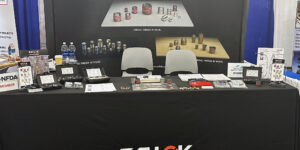SEE THE LIGHT: SUPER QUENCHING
Operating Inside A Vacuum: The cooling process is critical to manufacturing powdered metal products because it alters the metallurgical properties of the metal as it hardens. This subcontractor helped a new concept in vacuum furnaces take rapid cooling to a new level of precision ? another example of high tech opportunities available to contract manufacturers.
Posted: November 19, 2009
Most people have no idea that the casing on their cell phone is probably made from powdered metal. Ditto for the case on their wristwatch and the hinges that hold their eyeglasses together. Also, those same folks are probably not aware of the advanced, high-tech heating/cooling processes used to transform the powdered metals that made these and hundreds of other products.
That?s perfectly okay with Suresh Jhawar, because in the long run those people probably don?t care anyway. But as CEO of G-M Enterprises (Corona, CA), a world leader in the manufacturer of vacuum furnaces, he knows full well that his customers do care a great deal and rely on his equipment to produce high quality products for their own customers (end-users).
Jhawar hails from India where he earned a Bachelor of Science in Physics and Mathematics at the University of Calcutta. Years ago he immigrated to the U.S. and earned a bachelors degree in Mechanical Engineering with emphasis in Heat Transfer and Thermodynamics, along with an MBA from Marquette University. He has worked in the furnace industry since the 1970s and joined G-M in 1987. He eventually bought the company from the founders and led its transition from a service company for furnaces to becoming a manufacturer and marketer of vacuum furnaces.
?We were only a California company in the beginning, so our next objective was to go national,? notes Jhawar. ?We went international in 1989, soon after I was approached by a friend at a trade show in France who wanted to buy one of our vacuum furnaces.? G-M furnaces now operate in Bangkok, Brazil, Canada, China, Dubai, England, Hungary, India, Ireland, Israel, Japan, Mexico, Romania, Singapore, and Taiwan.
His wife Veena, who is president of G-M, also came from India and has an undergraduate degree in Education and a Masters in Economics. She oversees cost controls, while maintaining a high level of quality assurance in all of its products.
G-M has grown into a $20 million company with 50 employees. 30 percent of sales come from international markets and 70 percent from domestic markets. Besides cell phone and watch companies, its core customer groups include NASA, the aircraft engine industry, turbine manufacturers for electric and gas powered generators, and companies that produce medical implants for joint replacements. G-M furnaces are also used by manufacturers of tool and die, golf clubs, and automotive parts.
?During the last three years, every year has been better that the one before. 2008 was our best ever,? he says. ?We started off 2009 about 30 percent off, but overall we expect our business to only be about 20 percent off by the end of the year.?
The rise in production of parts and products made from powdered metals during the last few decades has been due in large part to increased costs of fabricating parts from sheet metals. Jhawar could see the trend coming and positioned his company to meet demand.
He formed a strong relationship with Super Radiator Coils (SRC; Chaska, MN) to manufacture high performance heat exchanger coils that rapidly cool down G-M?s vacuum furnaces and the products inside them at precise temperatures and rates.
Founded in 1927, SRC is a $76 million company that employs 320 people at its plants in Phoenix, AZ; Chaska, MN; and Richmond, VA. It manufactures condenser, evaporator, steam and other coils for more than 20 industries, including HVAC equipment manufacturers; chemical producers; petroleum operations; pharmaceuticals; pulp and paper companies; food processing, storage and display equipment; and textile makers.
Twenty years later their partnership continues, including G-M?s reliance on SRC to develop an advanced, round heat exchanger coil for a totally new concept in vacuum furnaces called Quantum Quench?.
The new furnace resembles a horizontal cylinder about the size of a large pickup truck and is available in seven models that range in load capacities from 1,200 to 4,500 lb. The new series gets its name from the cooling arrangements that divide the inside of the furnace into four quadrants. Super rapid cooling, or ?super quenching,? can be done in one of the quadrants or in any combination to control distortion and metallurgical properties of the products being produced. ?This furnace provides much faster quenching in the areas needed, when needed,? explains Jhawar. ?Whatever was being heated before in a vacuum furnace at four atmospheres of pressure can now be done at two atmospheres in this system, which saves energy and money.?
EXTERNAL OR INTERNAL QUENCHING
G-M manufactures two basic types of electric vacuum furnaces at its Corona facilities. External quench furnaces, which the company pioneered, have square or rectangular shaped cooling coils outside the heating chamber. According to Jhawar, this type of furnace provides superior quenching, easier access to the motor housing, fan and coils for maintenance, and accounts for about 80 percent of G-M sales.
The coils consist of all copper tubes and fins for faster heat transfer. They position 90 cooling fins per foot to remove 20 percent more heat faster than the standard 50 fins per foot.
The other 20 percent of sales come from internal quench furnaces that have the unique, round heating coil inside the heating chamber. ?A round configuration improves and transfers heat more effectively,? says Jhawar.
The Quantum Quench is available in an external model with an internal heat exchanger coil arrangement.
?We gave Super Radiator some hand sketches of what we needed in a round coil and they took the engineering and manufacturing from there,? he remembers. SRC?s proprietary design for these round coils can be built with up to eight rows of circular copper tubes and fins. The highly efficient coils take three to five days to manufacture in their plant in Phoenix, AZ, where each row is formed and assembled separately by hand. The rows are placed on top of each other with the ends of each tube fitted to a header that enables coolant to circulate freely throughout the entire coil.
INERT GAS TRANSFERS HEAT
Vacuum furnaces do not use oxygen inside the heating chamber, because heating metals in a vacuum maintains the purity of the metal. If oxygen were present, the parts being heat treated would oxidize, which in turn would create imperfections in the metal.
Instead, heat is transmitted from the metallic parts by injecting an inert gas, such as nitrogen, argon, helium or hydrogen, into the chamber during the cooling/quenching process. Inert gases do not interact with the powdered metal parts or solid metals, such as titanium, stainless steel, and super alloys.
As indicated above, pressure inside the chamber is also precisely controlled from 1 to 10 torr, a unit of pressure that is equal to approximately 1.316 x 10 atmospheres or 133.3 pascals. Again, this depends on the application and is used to minimize the depletion or vaporization of the metal being processed.
?After the metal has been heated for the right amount of time, high water flow in the heat exchanger is used to cool things down rapidly,? explains Jhawar. ?During heating, 30 to 40 gal of water-per-minute runs through the heat exchanger. But during quenching we?ll rush 150 to 600 gpm through the coils.?
Quenching is done in a re-circulating, closed-loop system. A blower at one end of the chamber pushes the inert gas through a double wall to nozzles at the other end. The hot gas exits the chamber, passes over the cooling coils in the heat exchanger and is re-circulated into the chamber. This arrangement is energy efficient, while providing optimum metallurgical properties for the parts being processed.
Both heating and quenching of the interior of a vacuum furnace are critical steps in the production of powdered metal products because they alter the metallurgical properties of the metal. Heating powdered metal, a process called sintering, causes the powder to form a coherent mass without melting. Rapid quenching hardens the metal, a process that was discovered in ancient times to make weapons and more recently to harden horseshoes before putting them on the animals.
Today?s products that are manufactured in this method are made from exotic metals that have very high melting points, such as titanium, super alloys and columbium. These include components for the aerospace industry, which accounts for 70 percent of G-M sales. Their electric furnaces heat up to 3,000 deg F, which is higher than most competing furnaces.
FROM INFERIOR TO SUPER
?Before we partnered with Super Radiator, we used a local company to produce our coils, but heating and quenching were becoming more and more critical,? states Jhawar. ?Eventually we had a failure with their coils and the vendor did not own up to the problem. The situation led to litigation . . . that?s when we began looking around and found Super Radiator.?
?Overall they continue to do a good job for us,? he continued. ?A couple of times their coils underperformed, but that was actually due to the size of the coil that we specified. We fixed the problem and bought new, bigger heat exchangers from them.?
– – – – – – – – – – – – – – – – – – – – – – – – – – – – – – – – – – – – – – – – –
Richard Parrish is president of marketing firm MindShare Communications, minsharcom@msn.com.
G-M Enterprises, Corona, CA, www.gmenterprises.com.
Super Radiator Coils, Chaska, MN, www.superradiatorcoils.com.









